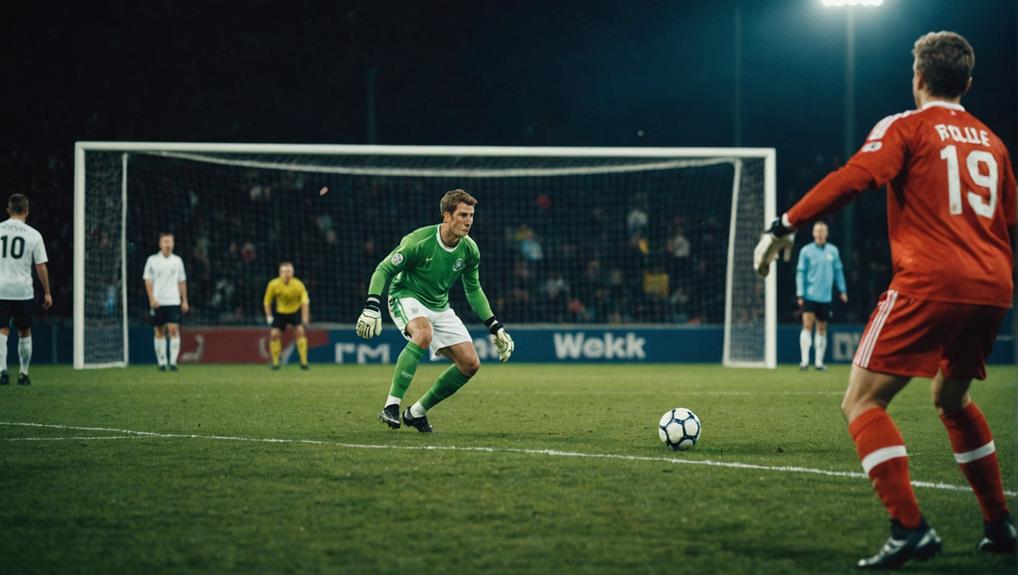
Essential Rules for Soccer Goalies
July 9, 2024To be a top goalie, master field presence and communicate with your team. Wear a distinct jersey for easy identification. Understand substitution rules. Control the ball wisely within the 6-second limit. Remember, no hands when scoring! Prioritize safety with referee protection. Succeed by following handling restrictions and ball control limits. Observe penalty kick rules carefully. And hey, there's more to learn about defending the goal effectively.
Field Presence
To excel as a soccer goalie, you must master the art of field presence. Your role as a goalkeeper is vital in protecting the goal and organizing the defense. With your unique position, you have the advantage of seeing the entire field and directing your players accordingly. You must constantly communicate with your teammates, guiding them on when to press forward or drop back to defend. As the last line of defense, your presence is felt throughout the game.
When the opposing team is attacking, your field presence becomes even more essential. You must be ready to react quickly, anticipate the player's next move, and position yourself to make a save. Inside the penalty box, you have the authority to use any part of your body to touch the ball, giving you the flexibility to block shots with your hands, feet, or even your back.
Mastering field presence as a goalkeeper isn't just about making saves, but also about commanding the field and instilling confidence in your team.
Uniform Requirement
Mastering field presence on the soccer field, goalkeepers must adhere to the uniform requirement of wearing a different-colored jersey to guarantee easy recognition by both teammates and referees.
This specific rule places the goalkeeper above every player concerning uniform regulations. The distinct attire of soccer goalkeepers isn't just a choice but a necessity to guarantee quick identification during the game.
The different-colored uniform is a key component of goalie equipment, designed to stand out and denote the player's position on the field clearly. Referees rely on this unique clothing to distinguish the goalkeeper from other players swiftly.
Goalkeeper Substitution
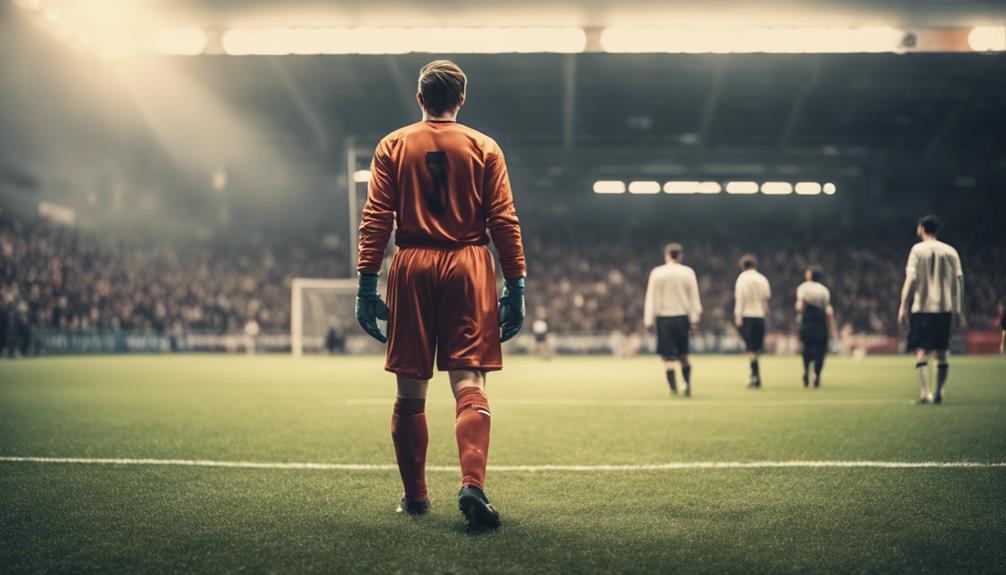
When considering goalkeeper substitution in soccer matches, it's important to understand the rules and implications surrounding this strategic decision.
A goalkeeper substitution can occur if the starting goalkeeper is injured, receives a red card, or for tactical reasons. Teams can make up to three substitutions per match, including a goalkeeper substitution if necessary. It's essential to inform the referee of any goalkeeper substitution to guarantee a smooth change on the field. Failure to notify the referee about a goalkeeper substitution could lead to a yellow card for the substitute entering the game.
Goalkeeper substitutions aren't just routine changes; they're strategic moves that can greatly impact the flow and outcome of a match.
Coaches must assess the situation carefully before deciding to substitute a goalkeeper, as it can influence the team's defensive stability and overall performance. Being aware of the rules and consequences related to goalkeeper substitutions is crucial for every team aiming to succeed on the soccer field.
Handling Restrictions
You need to pay close attention to handling restrictions as a goalie.
Your glove size can greatly impact your ball control.
Mastering various ball handling techniques is important for your performance on the field.
Glove Size Importance
Selecting the appropriate glove size plays a critical role in a goalkeeper's ability to handle the ball effectively and minimize restrictions during play. Goalkeepers should make sure that their gloves have a snug fit to maintain a strong grip on the ball without compromising flexibility.
The right glove size not only enhances grip but also helps in preventing injuries and maximizing performance. When choosing gloves, goalkeepers should take into account the amount of padding provided to strike a balance between protection and comfort. Different brands and models offer a variety of glove sizes to accommodate individual hand shapes and preferences.
Ball Handling Techniques
Guarantee efficient ball handling as a goalkeeper by understanding key restrictions within the penalty box. As a goalkeeper, you have the privilege to handle the ball with any body part within the penalty box, except in scenarios involving back passes.
When you release the ball back into play on the ground, remember that you can't pick it up again unless it has been touched by another player. It's important to be aware that using your hands is prohibited if the ball is deliberately passed back to you by a teammate. Adhering to these handling rules within the penalty area is vital for fair play and maintaining the integrity of the game.
Mastering the skill of handling the ball with different body parts while respecting these restrictions is fundamental for your success as a soccer goalkeeper. Stay sharp, follow these guidelines, and elevate your game with these essential goalkeeper tips to prevent any goal-scoring opportunities for the opposing team.
Ball Control Limit
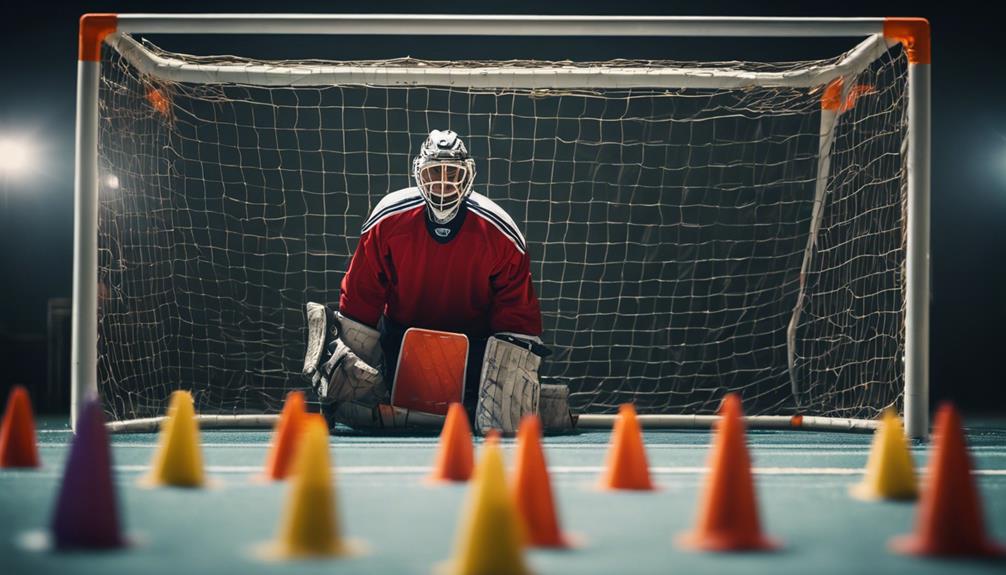
How long can a soccer goalkeeper legally control the ball before facing consequences? Goalkeepers are restricted by the 6-second rule when handling the ball during a game. This rule prevents time-wasting and aims to keep the game flowing smoothly.
If a goalkeeper surpasses the 6-second limit while having full control of the ball, the opposing team is granted an indirect free kick. To comply with this rule, goalkeepers must release the ball within the specified time frame by passing, kicking, or throwing it to a teammate.
Adhering to the 6-second rule not only avoids giving the opposing team an advantage but also encourages goalkeepers to distribute the ball quickly, enabling their team to shift from defense to offense efficiently. The control of the ball within this timeframe is essential for maintaining fair play and ensuring that the match progresses without unnecessary delays.
Dropping the Ball
When releasing the ball to their feet, goalkeepers make it playable for themselves to handle. It's vital for goalkeepers to be aware of the rules regarding intentional pass backs.
If a teammate deliberately passes the ball back using their feet, the goalkeeper can't pick it up. Doing so results in an indirect free kick for the opposing team. However, the goalkeeper is allowed to use their chest, knee, or head to control a pass back and then pick up the ball without penalty.
Referees are strict in enforcing these rules to guarantee fair play. Goalkeepers must be mindful of how they handle the ball after it has been deliberately passed back to them.
Passing Back Allowance
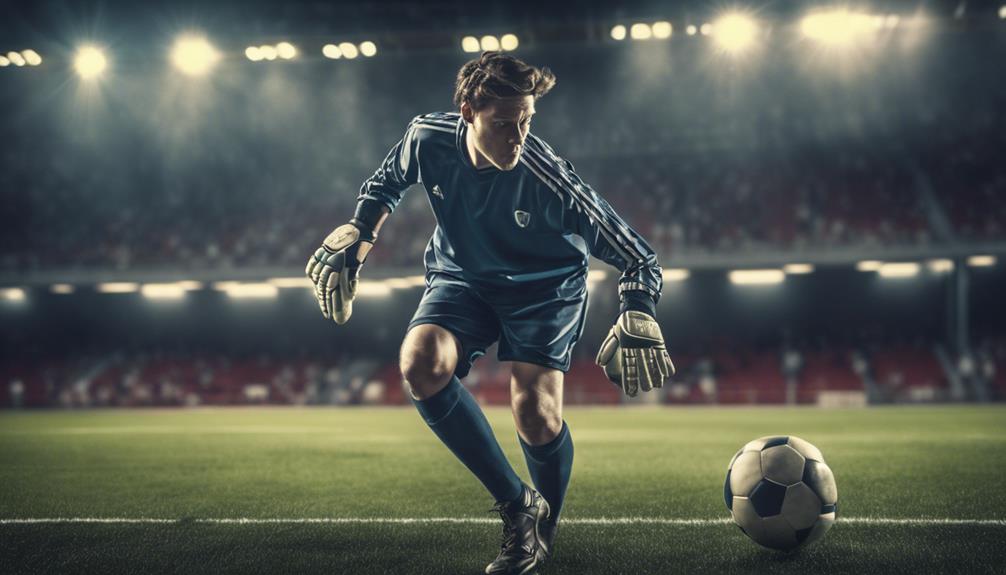
When considering the Passing Back Allowance, it's important to focus on key points like Passing Distance Limit, Communication With Defenders, and Timing and Decision-making. Understanding these aspects will help you navigate the rules effectively and make informed choices during gameplay.
Mastering these key points can enhance your performance as a goalkeeper and contribute to your team's success.
Passing Distance Limit
Within the penalty box, goalkeepers are permitted to handle the ball with any body part except when receiving a deliberate backpass from a teammate. The passing distance limit refers to the restriction on goalkeepers using their hands if the ball is intentionally kicked or thrown to them by a teammate.
If a goalkeeper handles a deliberate backpass, the opposing team is awarded an indirect free kick from the spot of the handling. However, goalkeepers are allowed to pick up the ball if it's played back to them using non-deliberate methods like the chest, knee, or head.
The backpass rule aims to prevent time-wasting by goalkeepers and ensures fair play by limiting their involvement with the ball. By enforcing the passing distance limit, the rule encourages goalkeepers to participate in the game actively and not rely on extended ball possession using their hands.
This regulation promotes a faster-paced and more engaging soccer match while maintaining the integrity of the game.
Communication With Defenders
Effective communication between goalkeepers and defenders is crucial in executing successful passing back plays during a soccer match. To ensure smooth passing back plays, following these guidelines is essential:
- Clear Signals: Use hand gestures and verbal cues to indicate when a backpass is safe.
- Eye Contact: Maintain visual contact to anticipate each other's moves during passing back situations.
- Quick Decision-making: Make swift decisions to prevent opponents from capitalizing on hesitation.
- Understanding of Rules: Familiarize yourselves with the rules regarding passing back to avoid penalties.
Referees are vigilant about enforcing rules to prevent goalkeepers from time-wasting by handling deliberate backpasses. By communicating effectively with defenders, goalkeepers can navigate passing back scenarios smoothly and avoid potential penalties. This collaboration not only enhances the team's defensive strategy but also minimizes the risk of turnovers that could lead to scoring opportunities for the opposing team.
Timing and Decision-making
For goalkeepers, mastering the timing and decision-making involved in receiving back passes is essential for successful gameplay.
When a back pass is made to you, remember that you have only six seconds to release the ball back into play. Passing the ball back using the head, chest, or knee allows you to pick it up with your hands, giving you the advantage of control.
However, if a deliberate pass back is handled by the goalkeeper, it results in an indirect free kick for the opposing team.
To avoid rule violations, be mindful that you can't pick up the ball if it's passed back to you using the feet.
Thus, quick thinking and strategic decision-making are pivotal in these situations to maintain possession and keep the game flowing in your team's favor.
Mastering the art of receiving back passes can elevate your performance as a goalkeeper and contribute significantly to your team's success.
Scoring Restrictions
Goalkeepers are prohibited from scoring using their hands or arms during a soccer game. This scoring restriction is essential in maintaining the integrity and fairness of the game.
Here are some key points to remember about scoring restrictions for goalkeepers:
- No Hands Allowed: Goalkeepers aren't permitted to use their hands or arms to score a goal under any circumstances.
- Consequence of Violation: If a goalkeeper does score using their hands or arms, it results in a goal kick being awarded to the opposing team.
- Focus on Defense: The primary role of goalkeepers is to prevent goals rather than actively seeking to score them.
- Violation of Rules: Scoring with hands or arms is considered a violation of the rules specifically designed for goalkeepers to uphold the principles of fair play and sportsmanship.
It is essential for goalkeepers to adhere to these scoring restrictions to maintain a level playing field and uphold the rules of the game.
Referee Protection
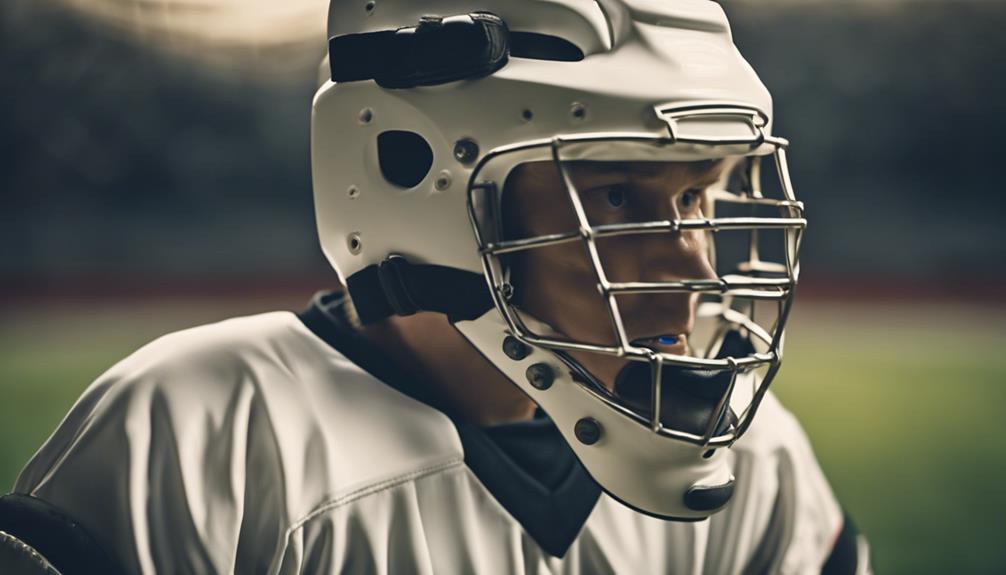
When it comes to protecting goalkeepers, referees employ specific shielding techniques to guarantee fair play.
Communicating effectively with officials is key to upholding the rules that safeguard goalkeepers during matches.
Referee Shielding Techniques
To guarantee fair play and protect the goalkeeper, referees employ specific shielding techniques during soccer matches. When it comes to shielding the goalkeeper, there are several key practices referees follow:
- Prioritizing Goalkeepers: Referees prioritize safeguarding goalkeepers in the penalty box above all players.
- Enforcing Foul Calls: Foul calls are made for offenses such as not releasing the ball or obstructing the goalkeeper.
- Ensuring Unobstructed Access: Goalkeepers must have unobstructed access to distribute the ball after making saves.
- Promoting Fair Play: Referees maintain fair play by penalizing actions that impede the goalkeeper's movements.
Communication With Officials
Referees in soccer matches uphold clear communication with officials to guarantee the protection of all players, including goalkeepers in critical game situations. When it comes to goalkeepers, referees prioritize their safety and fair play, particularly inside the penalty box.
It's vital for goalkeepers to have unhindered access to the ball for distribution, and any interference by opponents can lead to foul calls. Referees are vigilant in enforcing rules that prevent any challenges or obstruction that may impede the goalkeeper's actions.
By working closely with officials, goalkeepers can feel assured that they're safeguarded during matches. The collaboration between goalkeepers and referees ensures that the rules are upheld, and any infringements are addressed promptly to maintain the integrity of the game.
Penalty Kick Guidelines
During a penalty kick in soccer, goalkeepers are required to remain on the goal line until the ball is kicked. This rule is essential for ensuring fair play and giving the kicker an unobstructed chance to score.
Here are some important guidelines for goalkeepers facing a penalty kick:
- Goalkeepers must stay on the goal line until the ball is kicked, maintaining their position to defend the goal effectively.
- While on the goal line, goalkeepers are allowed to move laterally to anticipate the direction of the kick but can't advance forward before the ball is struck.
- The goalkeeper can't touch the goalposts, crossbar, or net before the penalty kick is taken, as it can be seen as an attempt to gain an unfair advantage.
- Only the goalkeeper is permitted to defend the penalty kick, standing between the goalposts and facing the kicker to block the shot effectively.
Conclusion
To sum up, remember to always maintain a strong field presence, follow uniform requirements, and be aware of the rules and restrictions that apply to goalies.
Keep in mind the importance of handling the ball correctly and passing back when necessary.
Stay focused, protect the goal, and be prepared for penalty kicks.
With these essential rules in mind, you'll be ready to excel as a soccer goalkeeper.


